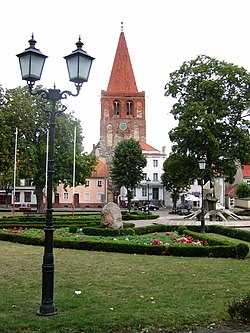Myślibórz
| Myślibórz | ||
|---|---|---|

Main square
|
||
|
||
| Coordinates: 52°56′N 14°52′E / 52.933°N 14.867°E | ||
| Country |
|
|
| Voivodeship | West Pomeranian | |
| County | Myślibórz County | |
| Gmina | Gmina Myślibórz | |
| Town rights | 1253 | |
| Area | ||
| • Total | 15.04 km2 (5.81 sq mi) | |
| Population (2006) | ||
| • Total | 11,867 | |
| • Density | 790/km2 (2,000/sq mi) | |
| Time zone | CET (UTC+1) | |
| • Summer (DST) | CEST (UTC+2) | |
| Postal code | 74-300 | |
| Area code(s) | +48 95 | |
| Car plates | ZMY | |
| Website | http://www.mysliborz.pl | |
Myślibórz [mɨˈɕlʲibuʂ] (German: Soldin; Kashubian: Żôłdzëno) is a city in north-west Poland, in West Pomeranian Voivodeship. It is the capital of the Powiat of Myślibórz (powiat myśliborski). Population is 11,867.
The city's official webpage mentions a settlement inhabited by a pre-Slavic population from Lusatian culture on the shores of the lake (Polish: Jezioro Myśliborskie; German: Soldiner See) in the 7th century, which later turned into a West Slavic fortress in the 10th and 11th centuries; the area was incorporated into Poland by the Piast duke Mieszko I by the end of the 10th century. According to the city's webpage, the town site was a fishing settlement called Sołtyń, located on trading route between Silesia and Greater Poland towards Oder delta. It is from this fishing settlement that the later German name of the town comes: Soldin.
The site was acquired as a rest house by the Dominican Order in 1234, while the fort was ceded to the Knights Templar and finally sold to the Ascanian margraves Johann I and Otto III of Brandenburg in 1261. Together with the nearby castellany of Santok, the former Greater Polish lands were incorporated into the Brandenburgian Neumark ("New March"; Polish: Nowa Marchia) territory. The town was first mentioned as Soldin in a 1270 deed and quickly became the administrative centre of the region, a Dominican monastery was founded there in 1275. However, in the first half of the 14th century Soldin declined due to famine and political strife of the Ascanian dynasty, in the course of which the Soldin Castle was destroyed. The Neumark area came under the control of the Teutonic Order in 1402, but in 1455 was re-acquired by the Margraviate of Brandenburg, now under the rule of the House of Hohenzollern. Elector Frederick Irontooth had Brandenburg’s suzerainty over the area formalized in the 1466 Treaty of Soldin with the Pomeranian dukes (see below).
...
Wikipedia


